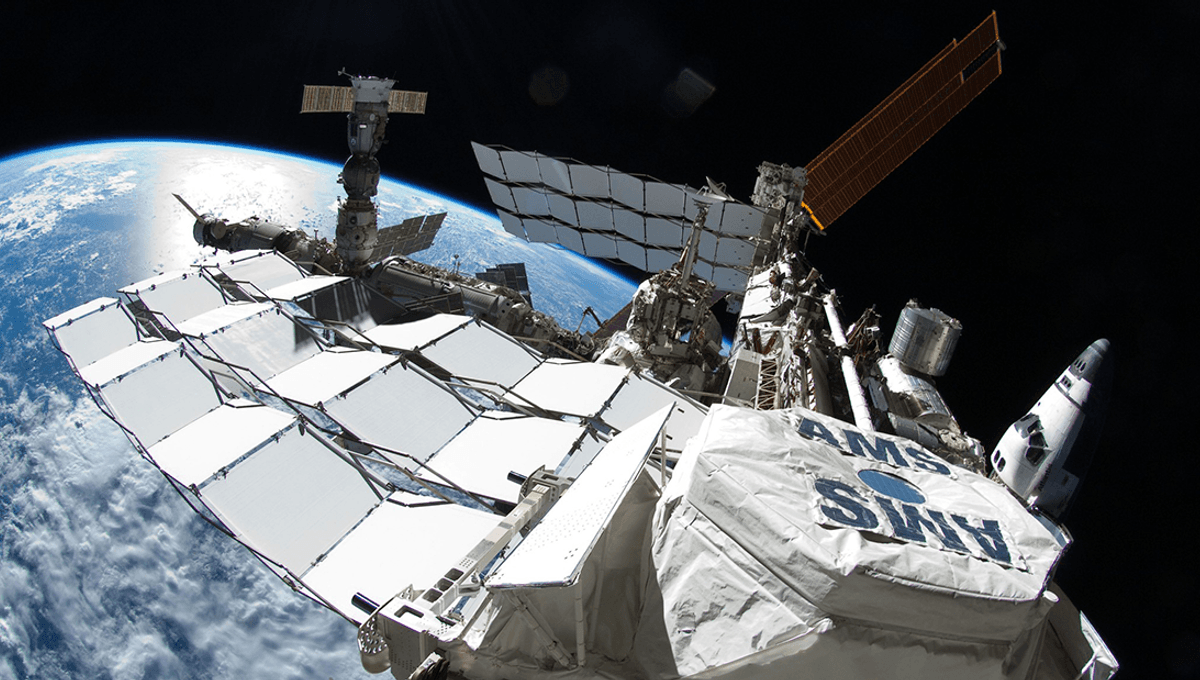
Attached to the International Space Station (ISS) is a state-of-the-art particle detector, tasked with searching for antimatter and dark matter, and performing precise measurements of the composition of cosmic rays.
The Alpha Magnetic Spectrometer (AMS-02) has collected over 239,017,100,611 cosmic events in the decade it has been mounted to the ISS. Within this data are some truly strange events that have been tentatively reported in presentations by the collaborators as the experiment continues.
The reported detection of 10 relativistic antihelium (He) cosmic-ray events is of particular weirdness.
Antimatter is essentially the same as ordinary matter except it has the opposite electric charge. It is made up of so-called antiparticles. Every particle is thought to have an antimatter companion with the opposite charge. For example, an electron has a negative charge but its antiparticle, a positron, has a positive charge. When these two particles meet, they annihilate each other.
One of the many puzzles of antimatter is the continued existence of the universe. In short, we can’t really tell why there is much more matter than antimatter. Scientists expected both types of particle to be produced during the Big Bang, so why didn’t the universe pretty quickly annihilate itself?
We can study antimatter using high-energy collisions in particle colliders, which can produce a small amount of antimatter. But we can also look at cosmic rays – highly energetic particles ejected from stars including our Sun’s flares, neutron stars, supernovas, or when matter falls into supermassive black holes.
Antihelium-3 and antihelium-4 have now been reportedly detected by AMS-02, containing antiprotons and antinucleons together. While antihelium 3 and 4 have been produced by the Large Hadron Collider and the Relativistic Heavy Ion Collider, we still don’t know a lot about either isotope of antihelium, or how they are produced in nature.
In a new paper, a team has attempted to explain how the antimatter could have come into existence, prior to being flung across the cosmos all the way to a space station orbiting Earth. These explanations lie at the edges of our understanding of physical processes, and will require more observations and work to back up or discount. The team suggests that the process behind the antihelium-4 likely took place in rapidly expanding “thermalized fireballs” of plasma, subject to relativistic effects.
“For appropriate initial conditions set by the initial radius, temperature, and antibaryon-to-entropy ratio of the plasma, the evolution of these fireballs is such that their thermal pressure drives the system toward a regime where there is relativistic bulk radial motion of a thin shell of plasma, in which the temperature of plasma falls as the expansion proceeds,” the team writes in their paper.
“This permits purely [standard model] thermal antinucleosynthesis of elements (similar to BBN) to occur in the expanding, cooling thin shell, while the products obtain relativistic boosts with respect to the rest frame of the fireball. Eventually, for appropriate parameters, the expansion rate shuts off the antinucleosynthesis in a regime where the antinucleosynthetic products have not reached their thermodynamic equilibrium values, which allows the abundances of 4He and antitritium (which later decays to 3He).”
Already complicated enough with thin shells of plasma undergoing relativistic effects, the team suggests that it’s possible for dark matter to be involved, offering an avenue to investigate.
“It would be plausible (at least in principle) for the required injection luminosity to be obtained via the collisions of supermassive, composite dark states (possibly a subcomponent of the dark matter),” the team explained, “provided that these otherwise individually cosmologically stable states can become destabilized in the collision in such a way that activates a decay channel that converts a non-negligible fraction of their mass energy to [standard model] antiquarks (and possibly some fraction of positively charged leptons), with this taking place both rapidly and in a localized region of space.”
Though an interesting avenue to explore, more detections will be needed and more work to be done to identify the source. For now, try to revel in the fact that antihelium nuclei are being flung across the cosmos, and are being detected by a space station humanity built.
The research is published in Physical Review D.
Source Link: What Is Causing The Antihelium Detected On The International Space Station?